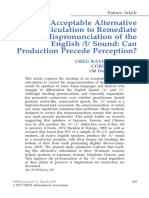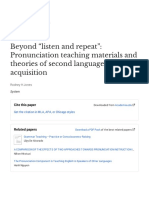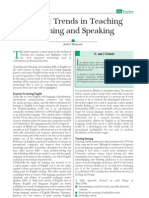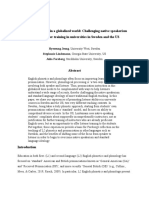Utopian Goals For Pronunciation Teaching: Tracey M. Derwing
Utopian Goals For Pronunciation Teaching: Tracey M. Derwing
Uploaded by
Brady GrayCopyright:
Available Formats
Utopian Goals For Pronunciation Teaching: Tracey M. Derwing
Utopian Goals For Pronunciation Teaching: Tracey M. Derwing
Uploaded by
Brady GrayOriginal Title
Copyright
Available Formats
Share this document
Did you find this document useful?
Is this content inappropriate?
Copyright:
Available Formats
Utopian Goals For Pronunciation Teaching: Tracey M. Derwing
Utopian Goals For Pronunciation Teaching: Tracey M. Derwing
Uploaded by
Brady GrayCopyright:
Available Formats
Derwing, T. M. (2010). Utopian goals for pronunciation teaching. In J. Levis & K. LeVelle (Eds.
),
Proceedings of the 1st Pronunciation in Second Language Learning and Teaching Conference,
Iowa State University, Sept. 2009. (pp. 24-37), Ames, IA: Iowa State University.
Utopian Goals for Pronunciation Teaching
Tracey M. Derwing
University of Alberta
As has often been noted in recent years, pronunciation instruction has received short shrift from
researchers and teachers alike. Although there is a small and committed body of individuals who
have worked to encourage the incorporation of pronunciation instruction in English as a second
language (ESL) classes, pronunciation still tends to be the neglected component of many language
programs. In this talk, some idealistic goals for pronunciation instruction will be laid out, and
suggestions for how the TESOL community might work towards achieving those goals will
addressed. Changes to teacher education, increased pronunciation research, optimal use of
technology, enhancement of listeners skills, and strategies for increasing students opportunities
to interact with native speakers are identified as potential approaches to meeting students
communication needs.
INTRODUCTION
In recent years several researchers and practitioners have pointed out that pronunciation seems to
be the orphan of second language research and teaching (Derwing & Munro, 2005). It tends to
be neglected in the second language (L2) classroom, and L2 teachers are somewhat intimidated
by the idea of teaching pronunciation (Burgess & Spencer, 2000). However, pronunciation, both
segments and prosodic factors (suprasegmentals) have been the subject of study for a very long
time, as has pronunciation instruction. In 1665, back in the day of long book titles, Owen Price,
master of arts and professor of the art of pedagogy, wrote a volume entitled The vocal organ, or
the art of teaching the English orthography, instruments of pronunciation, and the difference
between words of like sound whereby any outlander, or mere English man, woman or childe may
speedily attend to the exact spelling, reading, writing or pronouncing of any word in the English
tongue without the advantage of its fountains, the Greek and the Latin. Price concentrated
primarily on the study of segmentals of English, but in 1787, suprasegmentals were the focus of
attention in Walkers book, The melody of speaking delineated, or elocution taught like music by
visible signs, adapted to the tones, inflexions and variations of voice in reading and speaking
with directions for modulation and expressing the passions.
In 1904, Otto Jesperson wrote How to teach a foreign language, which was reprinted for the next
50 years. In his manual, Jesperson took language teachers to task for being afraid of the phonetic
alphabet and he argued that The use of phonetics and phonetical transcription in the teaching of
modern languages must be considered as one of the most important advances in modern
pedagogy, because it ensures both considerable facilitation and an exceedingly large gain in
exactness. But these means must be employed immediately from the very beginning (p. 170).
He went on to say that Just as easy as it is to get a good pronunciation in this way, just as
Utopian Goals | 25
difficult is it to root out the bad habits which may become inveterate during a very short period
of instruction according to a wrong or antiquated method (p. 176). With the advent of the
International Phonetics Associations Alphabet (IPA), Jesperson, along with others, thought that
pronunciation of a second language could be scientifically explained and improved. Roughly 50
years later, devoted teacher-educator, Earl Stevick (1957) made some key points with regard to
pronunciation teaching: start early accuracy matters; start big focus on pitch, stress and
rhythm; be consistent; spread your work 4 sessions of ten minutes are better than 1 session of
60 minutes; teach in terms of contrasts; and practice with connected speech. He called his
general approach the Oral Approach and it had the same basic principles of Audiolingualism,
including a strong emphasis on pronunciation and getting it right from the start. Both these
methods stressed the importance of good oral productions.
Another method that emphasized the importance of pronunciation was the Silent Way, in which
L2 students exposure to vocabulary was extremely limited in the first month. All their words
were represented in wall charts and each letter was colour-coded to provide a visual
representation of sound and spelling correspondences. The Silent Way, in its pure form, was not
practiced in very many locations because it required considerable training on the part of the
teachers. But its founder, Caleb Gattegno (1976), maintained that the method was highly
successful in producing L2 speakers who had excellent pronunciation.
It is somewhat ironic that there could be an approach to teaching pronunciation that emphasized
silence on the part of the teacher, but it is similarly puzzling that the communicative approach,
which became widespread in the 1980s and is still very influential, would have so little to say
about accent. ESL instructors who learned to teach using the communicative approach had little
guidance when faced with students whose speech was almost completely unintelligible. There
were some materials available, primarily minimal pairs contrasts such as Nilsen and Nilsen
(1971), which were thought to help speakers of other languages to improve their productions.
All conceivable contrasts that students might have difficulty with were listed in Nilsen and
Nilsens volume, even the contrast between voiced and voiceless TH, despite the fact that
practically no one confuses these two sounds. It is far more likely that speakers would substitute
a t or an s for theta and a d or a z for thorn. There was a general consensus in the 1980s
among many teachers that pronunciation instruction was ineffective, and that the only activity
one could employ was repetition. It is not altogether surprising that this skepticism existed. In the
first place, very few ESL instructors at that time had any TESL or linguistics background. There
was limited access to good materials, with a few exceptions such as Jazz Chants (Graham, 1978).
The only available technology was the language master machine, which could read computer
cards. A student would record a sentence and feed it into the machine to compare his or her
productions with those of a model.
Selected Papers from the 1st Annual Conference on Pronunciation in Second Language Learning and
Teaching
26 | Tracey Derwing
UTOPIAN GOALS
It was during this period, the early 1980s, that significant numbers of Vietnamese speakers
arrived at the school where I taught ESL. Several students had an excellent grasp of English
syntax and vocabulary but had great difficulty making themselves understood when they spoke.
The phonology of Vietnamese, a tone language, differs dramatically from that of English. For
example, in Vietnamese there are only six contrasting final consonants and no consonant
clusters, compared to the over 200 word final consonants and clusters in English (Hultzn,
1965). My fellow ESL teachers and I learned how to teach pronunciation by trial and error; and,
although our students ultimately benefited, it wasnt an ideal situation. This raises the question of
what would be ideal. What would effective and efficient pronunciation teaching for L2 learners
look like in a Utopia? The following nine characteristics would surely be included: increased
attention from researchers; a focus on teacher education; appropriate curriculum choices;
improved assessment; focus on intelligibility/comprehensibility; more useful software and other
technology; a focus on enhancing native speakers listening; no scapegoating of accents; and
better strategies for integrating newcomers into the community. Let us go through these goals for
our field one by one.
1.
Increased Pronunciation Research
There are competing views as to the usefulness of applied linguistics research to the language
classroom teacher, but when it comes to pronunciation, I am firmly of the belief that such
research can be valuable. Take, for example, Hahns (2004) study, which showed that primary
stress makes a difference in how well people can understand utterances. This is helpful to know.
However, how much attention does pronunciation get from second language acquisition (SLA)
researchers? Adam Brown (1991) surveyed four journals between 1975-1988 and found that very
few articles on pronunciation were published during that time. There is still a very small
percentage of articles devoted to our field in the general ESL/SLA research journals, with a
range of 2.7% to 7.4% from 1999-2008 (Deng et al., 2009). Some would argue that research isnt
that useful; indeed recently there was a comment on a pronunciation listserv from an experienced
practitioner that was quite disparaging of research, and which suggested that intuition is all that
is necessary to design activities that will meet students needs. Unfortunately, that isnt the case.
Although there may be some individuals who are capable of determining what is best for the
students and then implementing appropriate classroom procedures, more people are likely to
avoid dealing with pronunciation altogether. Studies by Breitkreutz, Derwing & Munro (2002),
Burgess & Spencer (2000), and MacDonald (2002) conducted in Canada, Britain and Australia
respectively, all show that the phenomenon noted by Otto Jesperson in 1904 is still going strong.
L2 teachers are often worried that they arent well prepared to teach pronunciation, or even to
incorporate some pronunciation activities into their regular language classrooms. They feel as
though they dont know where to start.
Utopian Goals | 27
This is where research comes in. Practical research can help instructors to determine where to put
the focus. Flege (1988) showed that most of the phonological changes that immigrants make in
acquiring their L2 occur during the first year in the L2 environment. That is not to say that there
arent any changes after that, for Trofimovich and Baker (2006) demonstrated that there surely
are, but the first year is when the most progress is made in the absence of pronunciation
instruction. If that is the case, wouldnt it be helpful to have some longitudinal studies to know
which aspects of pronunciation will likely take care of themselves over time? Such information
would allow teachers to focus on more intransigent problems.
Consider the development of L2 vowels. Munro & Derwing (2008) collected speech samples six
times in the first year that two groups of adult ESL learners were in Canada. They were speakers
of Mandarin and Slavic languages (Russian, Ukrainian and one Serbo-Croatian). We extracted
vowels from the samples and conducted identification tests with human listeners who classified
the vowels as belonging to an English vowel category, or Other, and then we determined how
many productions were classified as the intended vowel. After one year, the identification scores
for the vowel in the word beat were very high. The Mandarins productions received a score of
97% and the Slavic language speakers had a score of 90%; in other words, the vowel in the word
beat was interpreted by listeners as the intended vowel most of the time. It would have been a
waste of precious classroom time to work on this vowel with these learners. However, the vowel
in the word bit presented quite a different story. The Mandarin speakers correct identification
score went from 31% to 41% in their first year; the Slavic language speakers scores on this
vowel also improved fairly dramatically, going from 20% to 48%, but neither group was able to
produce this vowel accurately even half the time. This vowel is therefore an ideal candidate for
instruction. It has a high functional load, which means that it differentiates a large number of
words, and learners, at least from these two language groups, arent going to make sufficient
improvement on their own. We have conducted a similar study with consonants and consonant
clusters in word-initial and word-final position (Munro & Derwing, forthcoming), and again, we
found that many segments and combinations of segments did not require any intervention. These
are just a few examples to show that research does have something to contribute to what teachers
do in the classroom.
2.
Focus on Pronunciation in Teacher Education
My second utopian goal is an increased focus on pronunciation in teacher education. Things have
improved since I first taught pronunciation, as Gilbert (2005), Celce-Murcia, Brinton and
Goodwin (1996) and others have published very useful resources for teachers. There are also
good student resources now available for use such as Hahn & Dickerson (1999), Grant (2001),
Reed and Michaud (2006) and others. Although this not an exhaustive list, we still have a long
way to go. First, there is a definite need for more courses for ESL teachers. In Canada, for
instance, there are very few TESL programs that offer a full course in teaching pronunciation.
Not only are there not enough courses in pronunciation pedagogy, there are TESL programs that
Selected Papers from the 1st Annual Conference on Pronunciation in Second Language Learning and
Teaching
28 | Tracey Derwing
have no requirement for even an introductory course in Linguistics, which is surprising indeed.
In addition to initial training for all ESL teachers, there is also a role for ongoing professional
development. Our colleagues Lynda Yates and Beth Zielinski in Australia are developing a web
resource to do just that, and I hope that other universities will emulate this initiative. Ive
already mentioned some studies that indicate that many ESL teachers dont feel comfortable
dealing with pronunciation, but what about teachers in content classes? An increased focus on
pronunciation should extend to K-12 classroom teachers as well, even though they are not
necessarily designated as language teachers per se. Consider this advice from a teacher
publication to social studies teachers for helping their immigrant L2 students. Adjust speech
rate and enunciation. While English is a stress-timed language, many other languages, including
Spanish, are syllable-timed languages. English tends to stress one or two syllables and slur the
rest of the word or sentence. This means that English sounds are often unclear to some speakers
of other languages. Thus, pronouncing equally stressed words or sentences may increase
students comprehension along with adjusted speech rate (Cho & Reich, 2008, p. 239) (italics
added). This is a case where a little knowledge can be a bad thing. Regardless of what you think
about the stress-timed vs. syllable timed debate, the kind of language advocated by Cho and
Reich is not what students from a diverse set of language backgrounds need to hear. Teachers
should be modelling accurate pronunciation, not trying to imitate their L2 students by putting
equal stress on every syllable. We want our students to be able to communicate with other
people in the community; in an immigrant setting that means adopting the local version of
English. They need to hear which syllables have reduced vowels and which do not. All teachers
would benefit from an increased understanding of L2 pronunciation.
3.
Appropriate Curriculum Choices
The next goal has to do with appropriate curriculum choices. Sometimes stand-alone
pronunciation classes can be helpful, particularly if there are large numbers of students who
share similar difficulties many people from different L1s will have problems with rhythm for
example. However, programs may not have sufficient numbers to run stand-alone classes, or
students may need to be working on other things, as well, and so need pronunciation to be
integrated into general listening and speaking classes. Students should be exposed to multiple
voices from a range of ages and dialects. Levis and Grant (2003) point to the lack of
systematicity in the inclusion of pronunciation in general ESL classes and provide some
suggestions for ways to incorporate pronunciation. It should naturally be a part of a speaking and
listening class, and yet it often isnt.
4.
Assessment
In the USA, there are assessments for international teaching assistants, but in other types of
language programs, and certainly in Canada, people tend to avoid assessing pronunciation.
However, as with so many other areas of language proficiency, if pronunciation were tested, it
would be taught. I understand that there may be a concern about what assessments could be used
Utopian Goals | 29
for, but I doubt that any problems assessment may cause would be any worse than what happens
to L2 speakers in the real world without assessment. I am in favour of the development of
assessment tools for pronunciation. We know there will be washback if there are tests, so it is
important to design good ones.
5.
A Focus on Intelligibility and Comprehensibility
The next goal is a focus on intelligibility and comprehensibility, rather than accentedness. These
terms have distinct meanings. Accentedness is a judgment of how much ones speech differs
phonologically from the local variety. It is often measured on a Likert-like scale (e.g., 1 = no
accent; 9 = extremely heavy accent). Comprehensibility is a judgment of how easy or difficult an
individuals pronunciation is to understand, and it can also be measured on a scale (e.g., 1 = very
easy to understand; 9 = extremely difficult to understand). Intelligibility is the degree to which a
listener understands a speaker; this can be measured in several different ways, including
transcriptions, comprehension questions, and listener summaries of productions. In other words,
accent is difference, comprehensibility is effort, and intelligibility is actual understanding.
In his special issue of TESOL Quarterly, Levis (2005) described two approaches to teaching
pronunciation: one of these follows the nativist principle, which holds that L2 speakers should
try as best they can to replicate a native-like accent. The intelligibility principle is the basis of
the other approach, which holds that L2 speakers should be comfortably understandable.
Recently, Abrahamsson and Hyltenstam published an extensive study in Language Learning
(2009), in which they examined the nativeness of nearly 200 individuals who spoke Swedish
as a second language. Spanish was the L1 of all the participants, who started learning Swedish
between the ages of 1 and 47 years. These people were selected because they self-identified as
being native-like in Swedish and all were extremely high proficiency. However, when compared
to native speakers in a battery of tests, none of the late learners (over the age of 11 when they
started speaking Swedish) had equivalent scores. Thus, despite their exceptional language skills,
these high proficiency L2 speakers were still not comparable to native speakers.
Abrahamsson and Hyltenstams finding suggests that native speaker performance should not be
the goal of L2 learners, but rather to aspire to the status of highly intelligible, easily
comprehensible bilingual speakers. However, as Levis (2007) noted, many ESL teachers are still
clinging to the nativist principle. Over the years, I have given many talks about intelligibility,
comprehensibility and accentedess, and very often someone will tell me that his/her students
want help with aspects of their accent that dont interfere with intelligibility such as the
interdental fricatives, which is invariably the prime example used. They say that their students
are compromised socially because they cant make these sounds. I seriously doubt that the TH
sounds are the only problem those individuals have. Many L2 users of English who dont make
those sounds, and who have no other pronunciation difficulties are accepted for who they are:
articulate, fluent speakers.
Selected Papers from the 1st Annual Conference on Pronunciation in Second Language Learning and
Teaching
30 | Tracey Derwing
6.
Useful User-friendly Software
My next utopian goal would be to see more development of easy-to-use and useful software. We
have some very good researchers in our field who have worked with technology, and there are
some good programs, but nowhere near enough. Teachers have been encouraged to use
resources such as PRAAT more than they do. This is unrealistic, however, because PRAAT was
designed for researchers, not for classroom teachers. Only the most conscientious pronunciation
teacher is going to tread in that territory, so it is necessary that more teacher-friendly resources
be developed. The key benefit of computer assisted pronunciation training is that it can be
individualized to the students needs, but as Levis indicated (2007), by and large, this hasnt
happened. Most commercial programs are still of the one-size-fits all variety, which means that
inevitably, students are going to waste considerable time if they go through them in lockstep
fashion. The problem here is that the market, with some notable exceptions, has focused on the
look of programs the bells and whistles, rather than the linguistic needs of the learners. Ideally,
software should be developed that the teacher could easily customize to his or her students
specific needs for individual practice.
Virtual worlds, such as Second Life, could be ideal places for learners to go to get practice
listening if they are a bit intimidated by real life circumstances. There are places in Second Life
where people can go now, but it would be more beneficial if there were places designed
specifically to expose learners to particular aspects of pronunciation that give them the most
difficulty. In a utopian world, automatic speech recognition would give learners the feedback
they need, but unfortunately, it is unlikely to reach an accurate enough level for some time.
There are current technologies, such as Skype and iChat, that have great promise for
opportunities to practice speaking comprehensibly with real listeners, but the extent to which the
average ESL teacher utilizes these resources to enhance pronunciation is a question in my mind.
7.
A Focus on the Native Listener
In a utopian world, at least an ESL, immigrantreceiving world, we would put more emphasis on
helping native speakers to understand accented English. It is ironic that we expect L2 learners
from many linguistic backgrounds to understand each other, as well as a full range of English
dialects, while at the same time, some native speakers make no adjustments for their L2
interlocutors.
A study of major impact in this area is that of Rubin (1992), who had two classes of psychology
students listen to a mini-lecture recorded by a woman whose own dialect of American English
was the same as that of the undergraduate students. However, in one class the students were
shown a photo of a Chinese woman and were told that she was the lecturer, and in the other
class, the listeners saw a picture of a Caucasian woman. The students in the class who saw the
Chinese photo actually understood less of the lecture than the students who saw the Caucasian
Utopian Goals | 31
woman, and they complained about her accent! Yet the researcher had used the same recording
in both classes. This tells us that expectations can have a major impact on listeners.
There are people in this world who are biased against immigrants, biased against people of
another race, biased against accents and essentially biased against difference of all types. There
is probably not much one can do about those individuals, but there are also many people who are
not anti-immigrant and not racist, but who are afraid to talk to L2 speakers because they dont
think they have the skills to understand accented speech. In a study that my colleagues and I
conducted (Derwing, Rossiter & Munro, 2002), we trained social work students to listen more
carefully to L2 speech. The participants changed their attitudes towards their own ability to
understand accents. By the end of a term, several reported a willingness to interact with L2
speakers that they hadnt felt before, and they also indicated having experienced success in real
life encounters, which they attributed to the training.
In a more recent study, Kang, Rubin and Pickering (2008) designed an intervention in which
university students met with international teaching assistants to do a puzzle together and share a
pizza. Members of this group were more empathetic towards the teaching assistants after this
intervention.
So what can native speakers do to improve communication with a nonnative speaker? Not only
can they make more efforts to listen to accented speech, but they can follow the suggestions from
the Kbenhavns Sprogcenter, Dansk for Udlaendinge (Danish for foreigners). The Sprogcenter
produced posters that are distributed to workplaces all over Denmark, with the following 10 tips
for encouraging successful interaction of native speakers with nonnative speakers:
1. Imagine what its like to be in your colleagues shoes.
2. Involve your colleague in conversation.
3. Take time to listen.
4. Look at the person youre speaking to.
5. Say it in a different way if you are not understood.
6. Helping find the missing words.
7. Speak straightforwardly (e.g., dont use much slang).
8. Speak in a suitable tempo.
9. Dont mumble.
10. Give only a few instructions at a time.
8.
No More Scapegoating of Accent
The next goal is no more scapegoating of accent. A couple of years ago, the University
Teaching Services (UTS) unit at my university had several distressed international teaching
assistants and professors who were devastated by the very poor teaching evaluations they had
Selected Papers from the 1st Annual Conference on Pronunciation in Second Language Learning and
Teaching
32 | Tracey Derwing
received, all of which blamed their L2 accents. These individuals came to UTS for help, and
UTS approached me and two of my colleagues, one from Drama and one from Speech
Pathology, to see if we could assist them.
We recruited six volunteers from the group that had approached UTS and videoed them in their
own classes at the beginning of term, then worked with them once a week for 10 weeks. We
videoed them again at the end of term, and compared their teaching evaluations pre and post
intervention. The results were overwhelmingly positive (Derwing, Moulton, Campbell &
Dumas, forthcoming). What is important, though, is that we did very little work on the
participants pronunciation. When we analysed the initial videos, we determined that most of the
speakers were actually quite comprehensible from the outset. With one exception (an individual
who had a persistent stutter in both L1 and L2) their problems had more to do with limited
teaching skills. We focused on presentation skills (such as making eye contact with the
students), and pedagogical skills (such as using a handout instead of the blackboard). At the end
of the term, one of our participants received a teaching award; the change in his performance was
amazing. We regret that we didnt apply for ethical clearance to show the videos publically,
because overall, the before and after differences were so dramatic. But there was very little
change in pronunciation, because we didnt work on that, other than focusing on projection, and
ensuring that the participants knew the appropriate word stress patterns for the key vocabulary in
their fields. Our participants own undergraduate students had blamed L2 accent in their course
evaluations, because accent was so salient, and it blinded them to what the real problems were.
There are two other aspects of language that contribute to a lay listeners sense that an L2
speaker has a difficult-to-understand accent. One of these is pragmatics, or knowing what is
appropriate to say in a particular context. If someone uses unexpected phrases or lexical items,
they may not be understood, because of the generally high predictability of much of our
everyday language. The listener expects to hear one thing, and when something else comes
along, he or she cant understand it. Unexpected grammatical patterns, too, can cause problems
that will be blamed on pronunciation (Varonis & Gass, 1982). Work on appropriate use of
language (e.g., Yates, 2004) may well result in a perception of improvement in pronunciation.
9.
Better Strategies for Integrating Newcomers into the Community
Some may question what integration strategies have to do with pronunciation teaching, but the
extent and quality of exposure that speakers have to their L2 affects their comprehensibility
(Derwing, Munro & Thomson, 2008). So how can we help newcomers increase their
opportunities for speaking? Certainly in the ESL programs in Canada, we could concentrate
more on conversational strategies while people are in their language classes. The focus right
now is heavily weighted to grammar, reading and writing, but if people came out of those
courses with stronger speaking skills, they may have a heightened willingness to communicate.
ESL courses could have built-in supports, such as ethical volunteering opportunities, as
recommended by Dudley (2007), which would benefit L2 learners and cooperating institutions
Utopian Goals | 33
alike. The workplace, too, could become more L2-friendly and forward-looking companies
already realize that it is in their best interests to encourage good communication among
employees. If we consider the Mandarin and Slavic language speakers in our longitudinal study
(Derwing, Munro & Thomson, 2008), a major difference between the two groups was the
amount of exposure they had to English on a daily basis, including conversations at work and
with neighbours, TV viewing, radio and movies. The Slavic language speakers showed
improved comprehensibility and fluency over time, in the absence of instruction, whereas the
Mandarin speakers did not improve. Clearly more interaction can enhance comprehensibility
and fluency. For one thing, it provides for more opportunities for noticing, just as in other
aspects of L2 acquisition.
CONCLUSION
Perhaps in setting these utopian goals, I was aiming a little low. The goals I have laid out are
actually less than utopian, and ultimately achievable. I think that our field is poised to make a
significant and lasting difference right now. There have been more PhD students studying L2
pronunciation in the last three years than I can remember in the 15 years before that. It is
conceivable that most teacher preparation programs could introduce at least some focus on L2
pronunciation issues, and that pronunciation could be better incorporated into L2 curricula, and
better assessed. We are now at a point where most L2 teachers recognize that there is nothing
wrong with having an accent, and that intelligibility and comprehensibility should be the goals of
L2 speakers, not native-like status. Technology is advancing; there is a real role for virtual
worlds and other sorts of practice opportunities, informed by research. Finally, there are always
at least two people involved in real communication and both sides should be striving to achieve
communicative success, rather than putting all the responsibility on the shoulders of the L2
speaker. Here I am addressing an ESL reality, as opposed to English as an international
language. Native speakers need to loosen up a little, and make a bit more effort. We in the field
of pronunciation teaching and research are the people best equipped to help them. For those of us
who teach at universities and colleges, we can start with our own students. We are on the verge
of a major shift in attitudes and it is our job to speed up change. In conclusion, perhaps this talk
was wrongly titled after all. Instead of Utopian Goals for Pronunciation Teaching, perhaps it
should simply have been called Our To-Do List.
ACKNOWLEDGEMENTS
Much of the research discussed here was conducted with my colleague and friend, Murray
Munro. I would also like to acknowledge Ron Thomson and Lori Diepenbroek, who worked on
some of these studies. Thanks also to Lynda Yates, John Levis and Bruce Derwing for their
comments. I am grateful to the participants in our studies. Some of the research reported here
Selected Papers from the 1st Annual Conference on Pronunciation in Second Language Learning and
Teaching
34 | Tracey Derwing
was supported by the Social Sciences and Humanities Research Council of Canada and the
University of Alberta.
ABOUT THE AUTHOR
Tracey Derwing is a professor of TESL in the Department of Educational Psychology at the
University of Alberta, and Co-Director of the Prairie Metropolis Centre for Research on
Immigration, Integration and Diversity. In collaboration with Murray Munro she has carried out
extensive research on second language learners oral fluency and pronunciation, particularly the
extent to which accent interferes with intelligibility. In addition, she has studied the effects of
modifications native speakers make when addressing low proficiency speakers of English. She
has also worked with colleagues on large studies of the settlement experiences of refugees in
Canada. Most recently, she has conducted studies on English in the workplace, from the
perspectives of both immigrant and Canadian-born employees. Email:
tracey.derwing@ualberta.ca
REFERENCES
Abrahamsson, N. & Hyltenstam, K. (2009). Age of onset and nativelikeness in a second
language: Listener perception versus linguistic scrutiny. Language Learning, 59, 249306.
Breitkreutz, J., Derwing, T.M., & Rossiter, M.J. (2002). Pronunciation teaching practices in
Canada. TESL Canada Journal, 19, 51 61.
Brown, A. (1991). Functional load and the teaching of pronunciation. In A. Brown (Ed.),
Teaching English pronunciation: A book of readings. London: Routledge.
Burgess, J. & Spencer, S. (2000). Phonology and pronunciation in integrated language teaching
and teacher education. System, 28, 191-215.
Celce-Murcia, M., Brinton, D. M., Goodwin, J. M. (1996). Teaching pronunciation: A reference
for teachers of English to speakers of other languages. Cambridge: Cambridge
University Press.
Cho, S. & Reich, G.A. (2008) New immigrants, new challenges: High school social studies
teachers and English language learner instruction. Social Studies, Nov/Dec., p. 239.
Deng, J., Holtby, A., Howden-Weaver, L., Nessim, L., Nicholas, B., Nickle, K., Pannekoek, C.,
Stephan, S., & Sun, M. (2009). English pronunciation research: The neglected orphan of
Utopian Goals | 35
second language acquisition studies. Prairie Metropolis Centre Working Paper Series,
WP05-09, Edmonton, AB.
Derwing, T. M., Moulton, B., Campbell, M. & Dumas, J. (in preparation) Accent as scapegoat:
Improving the instruction of international teaching assistants and professors.
Derwing, T. M. & Munro, M. J. (2005). Second language accent and pronunciation teaching: A
research-based approach. TESOL Quarterly, 39, 379-397.
Derwing, T. M., Munro, M. & Thomson, R. (2008). A longitudinal study of ESL learners
fluency and comprehensibility development. Applied Linguistics, 29, 359-380.
Derwing, T. M., Rossiter, M. J. & Munro, M. J. (2002). Teaching native speakers to listen to
foreign-accented speech. Journal of Multilingual and Multicultural Development, 23,
245-259.
Dudley, L. (2007). Integrating volunteering into the adult immigrant second language
experience. Canadian Modern Language Review, 63, 539-561.
Flege, J. E., (1988). Factors affecting the degree of perceived foreign accent in English
sentences. Journal of the Acoustical Society of America, 91, 370389.
Gattegno, C. (1976). The common sense of teaching foreign languages. New York: Educational
Solutions.
Gilbert, J. (2005). Clear speech: Pronunciation and listening comprehension in American
English, (3rd Edition). New York: Cambridge University Press.
Graham, C. (1978). Jazz chants. New York: Oxford University Press.
Grant, L. (2001). Well said: Pronunciation for clear communication. Boston, MA: Heinle &
Heinle.
Hahn, L. (2004). Primary stress and intelligibility: Research to motivate the teaching of
suprasegmentals. TESOL Quarterly, 38, 201- 223.
Hahn, L. D. & Dickerson, W. B. (1999). Speechcraft: Discourse pronunciation for advanced
learners. Ann Arbor: University of Michigan Press.
Hultzn, L. S. (1965). Consonant clusters in English. American Speech, 40, 5-19.
Jesperson, O. (1904). How to teach a foreign language. London: George Allen & Unwin, Ltd.
Kang, O., Rubin, D. & Pickering, L. (2008, March). Impact of rater characteristics and prosodic
measures of accentedness on ratings of international teaching assistants oral
Selected Papers from the 1st Annual Conference on Pronunciation in Second Language Learning and
Teaching
36 | Tracey Derwing
performance. Paper presented at the meeting of the American Association of Applied
Linguistics, Washington DC.
Levis, J. (2007). Computer technology in teaching and researching pronunciation. Annual
Review of Applied Linguistics, 27, 184-202.
Levis, J. (2005). Changing contexts and shifting paradigms in pronunciation teaching. TESOL
Quarterly, 39, 369-377.
Levis, J. & Grant, L. (2003). Integrating pronunciation in to ESL/EFL classrooms. TESOL
Journal, 12, 13-19.
MacDonald, S. (2002). Pronunciationviews and practices of reluctant teachers. Prospect, 17
(3): 318.
Munro, M. J. & Derwing, T. M. (2008). Segmental acquisition in adult ESL learners: A
longitudinal study of vowel production. Language Learning, 58, 479-502.
Munro, M. J. & Derwing, T. M. (forthcoming). Implications of naturalistic segment development
for pronunciation teaching technology.
Nilsen, D. L. F. & Nilsen, A. (1971). Pronunciation contrasts in English. New York: Simon &
Schuster.
Price, O. (1665). The vocal organ. Menston, Yorkshire: Scholar Press, A Scholar Press
Facsimile.
Reed, M. & Michaud, C. (2006). Sound concepts: An integrated pronunciation course. New
York: McGraw-Hill.
Rubin, D. (1992). Nonlanguage factors affecting undergraduates judgments of nonnative
English-speaking teaching assistants. Research in Higher Education, 33, 511-31.
Stevick, E. (1957). Helping people learn English: A manual for teachers of English as a second
language. Nashville TE: Abington Press.
Trofimovich, P. & Baker, W. (2006). Learning second language suprasegmentals: Effect of L2
experience on prosody and fluency characteristics of L2 speech. Studies in Second
Language Acquisition, 28, 1-30.
Varonis, E. & Gass, S. (1982). The comprehensibility of nonnative speech. Studies in Second
Language Acquisition, 4, 114-136.
Walker, J. (1787). The melody of speaking delineated. London: Printed for the Author and sold
by G.G.J. & J. Robinson in Pater Noster Row & T. Cadell in the Strand.
Utopian Goals | 37
Yates, L. (2004). The secret rules of language: Tackling pragmatics in the classroom. Prospect,
19, 3-21.
Selected Papers from the 1st Annual Conference on Pronunciation in Second Language Learning and
Teaching
You might also like
- Beyond Repeat After Me: Teaching Pronunciation to English LearnersFrom EverandBeyond Repeat After Me: Teaching Pronunciation to English LearnersNo ratings yet
- Sociolinguistics and Language TeachingFrom EverandSociolinguistics and Language TeachingRating: 1 out of 5 stars1/5 (1)
- A Brief History of Language TeachingDocument7 pagesA Brief History of Language TeachingWilly100% (9)
- Designing Authenticity into Language Learning MaterialsFrom EverandDesigning Authenticity into Language Learning MaterialsFrieda MishanNo ratings yet
- Cot Filipino Sanhi at BungaDocument3 pagesCot Filipino Sanhi at BungaIan Clyde Aguinaldo100% (2)
- Your Seminar Planning ChecklistDocument2 pagesYour Seminar Planning ChecklistAmber ChanNo ratings yet
- GraffDocument2 pagesGraffBrianna CruzNo ratings yet
- English Pronunciation in L2 Instruction - Chapter 1 2 and 3 - History of Pronunciation Teaching Techniques and Tools AttitudesDocument73 pagesEnglish Pronunciation in L2 Instruction - Chapter 1 2 and 3 - History of Pronunciation Teaching Techniques and Tools AttitudesCarla Palumbo100% (1)
- Explicit PhonologyDocument23 pagesExplicit PhonologyJawairia MunirNo ratings yet
- Bad Pronunciation 2 Gilakjani ANTEPROYECTODocument12 pagesBad Pronunciation 2 Gilakjani ANTEPROYECTOBrady GrayNo ratings yet
- Research Proposal ADocument4 pagesResearch Proposal AMark Patrics Comentan VerderaNo ratings yet
- Bad PronunciationDocument15 pagesBad PronunciationBrady Gray100% (1)
- Overview On PronunciationDocument8 pagesOverview On PronunciationNik ManNo ratings yet
- A New Approach To Teaching PronunciationDocument28 pagesA New Approach To Teaching PronunciationflorentynaforworkNo ratings yet
- Pronunciation Difficulties Analysis - A Case Study PDFDocument9 pagesPronunciation Difficulties Analysis - A Case Study PDF7YfvnJSWuNo ratings yet
- Nikbakht H. EFL Pronunciation Teaching - A Theoretical Review.Document30 pagesNikbakht H. EFL Pronunciation Teaching - A Theoretical Review.researchdomain100% (1)
- The Importance of Collocation in English Language Teaching (Copy Cite)Document6 pagesThe Importance of Collocation in English Language Teaching (Copy Cite)Nguyễn Kim KhánhNo ratings yet
- An L1 Point of Reference Approach To Pro PDFDocument13 pagesAn L1 Point of Reference Approach To Pro PDFviersiebenNo ratings yet
- THE IMPORTANCE AND PRINCIPLES OF TEACHING Pronunciation To LearnnersDocument4 pagesTHE IMPORTANCE AND PRINCIPLES OF TEACHING Pronunciation To LearnnersHiền PhanNo ratings yet
- Litriture Main-1Document67 pagesLitriture Main-1gardia1261No ratings yet
- Audio-Lingual Method - WikipediaDocument9 pagesAudio-Lingual Method - WikipediaToqeer TumraniNo ratings yet
- Antunez (2002)Document10 pagesAntunez (2002)Keith WheelerNo ratings yet
- Interlanguage Pragmatics and Second Language Acquisition Gabriele Kasper - University of Hawai ... (PDFDrive)Document15 pagesInterlanguage Pragmatics and Second Language Acquisition Gabriele Kasper - University of Hawai ... (PDFDrive)devyNo ratings yet
- Acceptable Alternative Articulation of The EnglishDocument21 pagesAcceptable Alternative Articulation of The EnglishNghia NguyenNo ratings yet
- Method of PronunciationDocument31 pagesMethod of PronunciationFaizal HalimNo ratings yet
- Integration Not Eclecticism - A Brief History of Language Teaching, 1853 - 2003Document9 pagesIntegration Not Eclecticism - A Brief History of Language Teaching, 1853 - 2003YanNo ratings yet
- Non Native EnglishDocument8 pagesNon Native EnglishXohaib YounasNo ratings yet
- Questions Teachers Ask About Spelling: Shane Templeton Darrell MorrisDocument11 pagesQuestions Teachers Ask About Spelling: Shane Templeton Darrell Morrisapi-269501601No ratings yet
- Praca LicencjackaDocument43 pagesPraca LicencjackaNatasza MoskałaNo ratings yet
- Phonology Assignment and Lesson PlanDocument45 pagesPhonology Assignment and Lesson PlanGeroNimoNo ratings yet
- Pronunciation Teaching Practices in CanadaDocument12 pagesPronunciation Teaching Practices in CanadaThu Quyên HoàngNo ratings yet
- Pronunciation in Action in The ClassroomDocument29 pagesPronunciation in Action in The ClassroomAndereeNo ratings yet
- PhonicsDocument12 pagesPhonicssapabapjava2012No ratings yet
- Methods/Approaches of Teaching ESOLDocument12 pagesMethods/Approaches of Teaching ESOLAnglophile123100% (2)
- Listen and Repeat With Cover Page v2Document11 pagesListen and Repeat With Cover Page v2Muh. Iqbal Kholik UIN MataramNo ratings yet
- TESOL Newsletter No. 1 August 2004Document31 pagesTESOL Newsletter No. 1 August 2004Yessenia LizasoaínNo ratings yet
- Keith Folse - Myths About Teaching and Learning Second Language Vocabulary PDFDocument13 pagesKeith Folse - Myths About Teaching and Learning Second Language Vocabulary PDFcommweng100% (2)
- Teacher 3Document3 pagesTeacher 3Ever LoveNo ratings yet
- "V" Vs "W" Sound Practised by Pakistani English SpeakersDocument44 pages"V" Vs "W" Sound Practised by Pakistani English Speakershoor maaniNo ratings yet
- History of English Language TeachingDocument5 pagesHistory of English Language TeachingGabriela RNo ratings yet
- Teaching Pronunciation - Useful For Commenting On Their Recorded UtterancesDocument8 pagesTeaching Pronunciation - Useful For Commenting On Their Recorded UtterancesSimonaStănescuNo ratings yet
- Pronunciation Strategies at Primary and Secondary Level of TEFLDocument11 pagesPronunciation Strategies at Primary and Secondary Level of TEFLMosa NgomaneNo ratings yet
- Framing English Sound-Letter Parallelism Teaching: RésuméDocument11 pagesFraming English Sound-Letter Parallelism Teaching: RésuméYvon-Pierre NDONGO IBARANo ratings yet
- HDL PPLNCKHDocument3 pagesHDL PPLNCKHkhuongpeo2005No ratings yet
- The Origins of Language TeachingDocument13 pagesThe Origins of Language TeachingLiezel Evangelista BaquiranNo ratings yet
- Preprint - Jeong Lindemann Forsberg - Listener Training in Sweden and The USDocument24 pagesPreprint - Jeong Lindemann Forsberg - Listener Training in Sweden and The USVeronica RosasNo ratings yet
- Lesson 4Document7 pagesLesson 4BlodiMerNo ratings yet
- English Language Learners and The Five Essential Components of Reading InstructionDocument6 pagesEnglish Language Learners and The Five Essential Components of Reading Instructionteachergrace1225No ratings yet
- English Language Learners and The Five Essential Components of Reading InstructionDocument5 pagesEnglish Language Learners and The Five Essential Components of Reading InstructionNallalagi MoorthyNo ratings yet
- Course Anthology Phonetics PDFDocument81 pagesCourse Anthology Phonetics PDFMax Arias SeguraNo ratings yet
- Language Teaching Methods and The Evolution of Linguistic Theory.Document14 pagesLanguage Teaching Methods and The Evolution of Linguistic Theory.Hassan BasarallyNo ratings yet
- Cushing Hellmuth 2016 Author Accepted VersionDocument12 pagesCushing Hellmuth 2016 Author Accepted VersionPaulaNo ratings yet
- Purwaniindriastuti,+Journal+Manager,+Layout+Article+3 5Document5 pagesPurwaniindriastuti,+Journal+Manager,+Layout+Article+3 5lusiana kusumayatiNo ratings yet
- 1 SM PDFDocument13 pages1 SM PDFRika AprianiNo ratings yet
- Approaches_and_methods_teaching_vocabulary_for_B1level_learnersDocument29 pagesApproaches_and_methods_teaching_vocabulary_for_B1level_learnersIroda DavletovaNo ratings yet
- The Decline and Fall of The Native SpeakerDocument5 pagesThe Decline and Fall of The Native SpeakerJames FidelNo ratings yet
- A Literature Review On Strategies For Teaching PronunciationDocument22 pagesA Literature Review On Strategies For Teaching PronunciationKavic100% (1)
- Dickey-2003-Imagery For Reɪt Pronunciation (Rightwrite)Document13 pagesDickey-2003-Imagery For Reɪt Pronunciation (Rightwrite)RJDNo ratings yet
- The English Linguistics Project: English Manual (8th Edition)From EverandThe English Linguistics Project: English Manual (8th Edition)Rating: 5 out of 5 stars5/5 (3)
- Manual of American English Pronunciation for Adult Foreign StudentsFrom EverandManual of American English Pronunciation for Adult Foreign StudentsNo ratings yet
- Activities Time ExpressionsDocument2 pagesActivities Time ExpressionsBrady GrayNo ratings yet
- Presente Perfecto (Part 3) - Just, Already, Yet, For y Since - PDF Descargar LibreDocument8 pagesPresente Perfecto (Part 3) - Just, Already, Yet, For y Since - PDF Descargar LibreBrady GrayNo ratings yet
- Possessive Pronouns82014Document1 pagePossessive Pronouns82014Brady GrayNo ratings yet
- Possessive Pronouns Vs Possessive Adjectives Grammar Drills Grammar Guides - 593Document2 pagesPossessive Pronouns Vs Possessive Adjectives Grammar Drills Grammar Guides - 593Brady GrayNo ratings yet
- Read The Letter and Answer The QuestionsDocument2 pagesRead The Letter and Answer The QuestionsBrady GrayNo ratings yet
- EXAMDocument2 pagesEXAMBrady GrayNo ratings yet
- Whose Bicycle Is This 1Document1 pageWhose Bicycle Is This 1Brady GrayNo ratings yet
- Are There BooksDocument2 pagesAre There BooksBrady Gray100% (1)
- Adverbs of FrequencyDocument2 pagesAdverbs of FrequencyKristian Díaz100% (2)
- Some Any Much Many A Lot of How Many How MuchDocument2 pagesSome Any Much Many A Lot of How Many How MuchBrady GrayNo ratings yet
- The Questions: - Use Full AnswersDocument2 pagesThe Questions: - Use Full AnswersBrady GrayNo ratings yet
- Tick The Correct Form of The Plural For The Given NounsDocument2 pagesTick The Correct Form of The Plural For The Given NounsBrady Gray100% (1)
- Atg Worksheet Pic ThereisthereareDocument2 pagesAtg Worksheet Pic ThereisthereareJosé Roberto100% (1)
- The Date PDFDocument3 pagesThe Date PDFBrady GrayNo ratings yet
- Quiz 3er Año Comparative and SuperlativeDocument1 pageQuiz 3er Año Comparative and SuperlativeBrady GrayNo ratings yet
- Ministerio de Educacion Y Ciencias Colegio Privado Familia de Nazaret Final ExamDocument2 pagesMinisterio de Educacion Y Ciencias Colegio Privado Familia de Nazaret Final ExamBrady GrayNo ratings yet
- Ministerio de Educacion Y Ciencias Colegio Privado Familia de Nazaret English QuizDocument1 pageMinisterio de Educacion Y Ciencias Colegio Privado Familia de Nazaret English QuizBrady GrayNo ratings yet
- Quiz 2do Año Was WereDocument1 pageQuiz 2do Año Was WereBrady GrayNo ratings yet
- Toolkit 1 - FeedbackDocument41 pagesToolkit 1 - FeedbackComaythang5No ratings yet
- How To Say I Love UDocument3 pagesHow To Say I Love UsgtangkasNo ratings yet
- Writing SectionDocument15 pagesWriting SectionUpma GandhiNo ratings yet
- Curriculum Design StrategiesDocument61 pagesCurriculum Design StrategiesQuốc Hưng Đặng TrầnNo ratings yet
- Lesson 3 FinalDocument4 pagesLesson 3 Finalapi-252252831No ratings yet
- Wi TribeDocument2 pagesWi TribeMian AsadNo ratings yet
- 7mar English Ref 2Document1 page7mar English Ref 2api-309400338No ratings yet
- 2800 Chapter 1Document58 pages2800 Chapter 1Shakeel AminNo ratings yet
- Nataly's Outline SilenceDocument2 pagesNataly's Outline SilenceCarlos OlivaresNo ratings yet
- Content GuidelineDocument25 pagesContent GuidelineVinh TranNo ratings yet
- Likiths AnneDocument113 pagesLikiths AnneArchana J RetinueNo ratings yet
- Teacher'S Portfolio Grade - Iii: Learning Delivery Modalities CourseDocument65 pagesTeacher'S Portfolio Grade - Iii: Learning Delivery Modalities CourseVilma TayumNo ratings yet
- WiMAX NotesDocument9 pagesWiMAX NotesPramod DokeNo ratings yet
- Bella Romero Academy - MattiviDocument4 pagesBella Romero Academy - MattiviCCSD Digital & Multimedia LearningNo ratings yet
- It's Good To Talk:: Oracy Lesson PlanDocument12 pagesIt's Good To Talk:: Oracy Lesson PlanpnnlarraNo ratings yet
- Data Communication Short NotesDocument3 pagesData Communication Short NotesNini LashariNo ratings yet
- 02 - Barriers To Effective CommunicationDocument17 pages02 - Barriers To Effective CommunicationJaripNo ratings yet
- Business Development ExecutiveDocument2 pagesBusiness Development ExecutivesimonbozzoliNo ratings yet
- InstructionsDocument3 pagesInstructionsolaNo ratings yet
- Universiti Teknologi Mara Scheme of Work Course Name: Introduction To Data Communication And: Networking Course Code: ITT300Document8 pagesUniversiti Teknologi Mara Scheme of Work Course Name: Introduction To Data Communication And: Networking Course Code: ITT300Deanial FikriNo ratings yet
- An Eclectic Approach For Teaching English A Key To Solve The Textbook Puzzle - 2019-03!13!11-09Document8 pagesAn Eclectic Approach For Teaching English A Key To Solve The Textbook Puzzle - 2019-03!13!11-09Impact Journals100% (2)
- Review Langacker 2008 PDFDocument4 pagesReview Langacker 2008 PDFWilliams D CH100% (1)
- ACR-LRP-grade 4Document7 pagesACR-LRP-grade 4Evelyn DEL ROSARIONo ratings yet
- Content Marketing Plan Sample PDFDocument18 pagesContent Marketing Plan Sample PDFYuleisi GonzalesNo ratings yet
- Introduction To Parliamentary DebateDocument8 pagesIntroduction To Parliamentary DebateRifsaptNo ratings yet
- Social Media Content Strategy at AyojakDocument7 pagesSocial Media Content Strategy at AyojakVaibhav SinghNo ratings yet
- Academic Reading StrategiesDocument2 pagesAcademic Reading StrategiesMaria GraceNo ratings yet











































































































